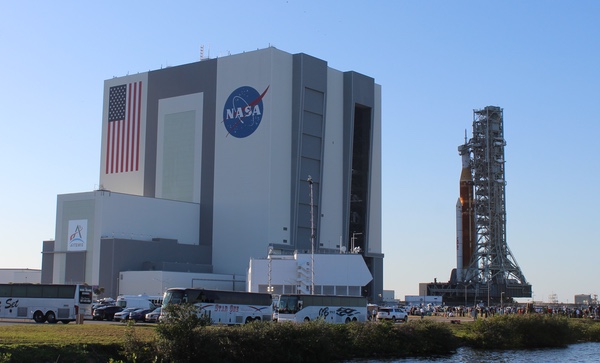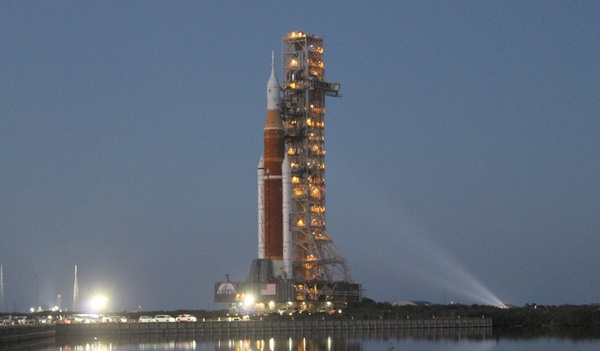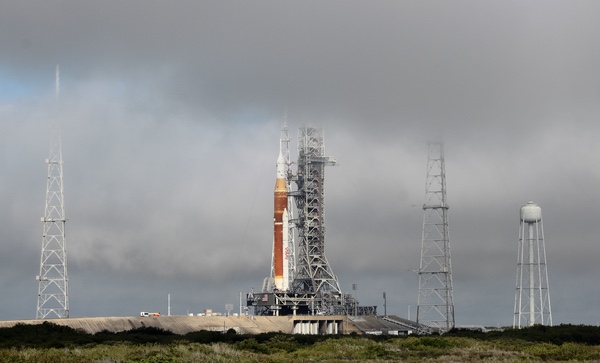SLS crawls towards its first launchby Jeff Foust
|
| “There is no doubt we are in a golden era of space exploration, discovery, and ingenuity in space, and it all begins with Artemis 1,” Nelson said. |
NASA bussed the media to a viewing site not far from the pad and waited until nearly 10 am, when the fog burned off enough to reveal the rocket on the pad in the mid-morning sun. After years of delays, waiting a couple extra hours to finally see the rocket on the pad was par for the course.
The previous afternoon, the SLS, with the Orion spacecraft on top, and its mobile launch platform emerged from the VAB, the first time a rocket bound for the Moon left that cavernous building in nearly half a century. A crawler-transporter slowly but steadily moved the massive stack out of the VAB, then paused for checks and reconfigurations, as planned.
That pause served as an opportunity for NASA to celebrate the emergence of the vehicle, although in a relatively low-key way. NASA administrator Bill Nelson gave remarks that celebrated the rollout as the latest key milestone towards the launch of the uncrewed Artemis 1 mission and broader progress on the Artemis program.
“There is no doubt we are in a golden era of space exploration, discovery, and ingenuity in space, and it all begins with Artemis 1,” Nelson said. “Artemis 1 will demonstrate NASA’s commitment and capacity to extend humanity’s presence on the Moon and beyond.”
But there wasn’t a parade of speeches by others in NASA or industry, or from politicians. A college band from the University of Central Florida provided musical accompaniment, and the agency released a NASA-themed video of the new song “Invincible” by Eddie Vedder (although the Pearl Jam frontman did not perform live at KSC.) NASA TV soon wrapped up its coverage of the rollout even though the vehicle was just starting its rollout to the pad that took more than ten hours to complete.
The rollout was low key, perhaps, because this was not for the Artemis 1 launch itself. Instead, the vehicle was going to LC-39B for a countdown test called a wet dress rehearsal (WDR), where the vehicle will be loaded with liquid hydrogen and liquid oxygen propellants and go through a practice countdown that stops at about T-10 seconds, just before the ignition sequence would start for the core stage’s four RS-25 engines.
“We’re going to get very late in the count, purposefully, and demonstrate all the interfaces,” said Mike Sarafin, Artemis 1 mission manager at NASA, during a briefing last month about the WDR.
 SLS begins its rollout from the VAB March 17. (credit: J. Foust) |
Before the actual fueling test, though, workers will test the various interfaces at the pad with the vehicle, as well as software and communications. “At Stennis we did two core stage firings, so we know the tank is sound, but that ground system is different from ours,” said Brad McCain, vice president and deputy general manager at Jacobs, the prime contractor for NASA’s Exploration Ground Systems, in an interview. That was a reference to the two Green Run static firings of the core stage in January and March of last year.
| NASA has been reticent to set a launch date for Artemis 1, but a firm date should come after WDR. “That’s the point where we’ll be in a good position as an agency to set a launch date,” said Whitmeyer. |
At a briefing last week, NASA said the actual WDR would take place on April 3. It will take eight hours to fill the SLS with propellants, far longer than the two and a half hours it took for the shuttle, reflecting the larger core stage as well as the upper stage, which also uses liquid hydrogen and oxygen. One effect of that longer fueling time, McCain said, is the need for two shifts of controllers to oversee the fueling and countdown, versus one for the shuttle.
That schedule may have to be adjusted, though. On Friday, Axiom Space announced its Ax-1 commercial mission to the ISS, launching on a SpaceX Crew Dragon from LC-39A, had slipped from March 30 to April 3. That would conflict with the WDR at the nearby LC-39B, and if both can’t be accommodated the same day for safety reasons, the WDR would be more likely to slip to avoid delaying the Crew-4 mission, which follows a couple weeks after Ax-1.
About a week and a half after WDR, the SLS will be rolled back to the VAB. The work there will depend on what comes out of the test, but at the very least NASA anticipates doing some final closeout work on the vehicle. McCain noted that might include minor repairs to the foam on the core stage after going through the cycle of fueling and detanking.
NASA has been reticent to set a launch date for Artemis 1, but a firm date should come after WDR. “That’s the point where we’ll be in a good position as an agency to set a launch date,” said Tom Whitmeyer, NASA deputy associate administrator for exploration systems development, at a briefing last week.
The agency is keeping open an option of a launch at the “tail end” of a launch window that runs from May 7 through 21. It’s more likely, though, that the launch will slip to the next window, June 6 to 16, or the following one, June 29 to July 12. (The launch windows are governed by several factors, including ensuring a daytime splashdown for Orion off the California coast at the end of the mission.)
 The stack continues its march to Launch Complex 39B at dusk. (credit: J. Foust) |
Congressional concerns
While the Artemis 1 launch might take place some time this summer, some recall that, when the vehicle was introduced more than a decade ago, it was expected to make its first flight around 2017. And even with a first launch of SLS this summer, future missions remain in flux, including a human return to the Moon currently scheduled for 2025.
“By all accounts, Artemis is facing significant challenges. The advisory boards, reviews, and audits are sounding warnings,” said Rep. Don Beyer (D-VA), chair of the space subcommittee of the House Science Committee, during a March 1 hearing of that subcommittee on the status of the Artemis program. “Schedule delays and cost growth years in the making, a confusion mishmash of contract types and untried approaches to organizations and management are just a few of the concerns that have been raised.”
| “By all accounts, Artemis is facing significant challenges. The advisory boards, reviews, and audits are sounding warnings,” said Beyer. |
The subcommittee had as witnesses representatives of several of those advisory boards and reviews to address their concerns, including the Government Accountability Office, Aerospace Safety Advisory Panel (ASAP), and NASA’s own Office of Inspector General. They recounted their issues with the progress on Artemis, including cost overruns, schedule delays, and concerns about how the program is managed.
“The Artemis 3 schedule remains challenging,” said William Russell, director of contracting and national security acquisitions at the GAO, citing a seven-month delay in starting SpaceX’s Human Landing System award because of protests and a lawsuit as one key factor. “It increases schedule risks as the program already planned to develop and launch the system months faster than other spaceflight programs and will need to mature critical technologies along the way.”
Paul Martin, NASA’s inspector general, reviewed the findings of a report last November on Artemis that concluded a single Artemis mission would cost at least $4.1 billion, a figure that includes the SLS, Orion, and ground systems, but not other components like a lunar lander. That, he said, is “a price tag that strikes us as unsustainable.”
Some members of the committee wanted more details about the overall Artemis program. “NASA needs to provide us with an updated plan, a precise timeline, and a realistic budget,” said Rep. Frank Lucas (R-OK), ranking member of the full committee. “Simply put: tell us how long it will take, how we will do it, and how much it costs. The Artemis program must be NASA’s highest priority.”
Jim Free, NASA’s associate administrator for exploration systems development, said such a plan was in the works as part of a new Artemis campaign development division within the agency. “We have a longer-term architecture we’re trying to put the final details on by the end of this year,” he said.
NASA may need to accelerate that timeline. When Congress finalized its fiscal year 2022 spending bill March 9, it provided full funding for most exploration programs, including an increase of more than $100 million above the request for SLS. However, language in the report restricts funding on several programs, including HLS, commercial LEO development, the lunar Gateway and other advanced exploration initiatives, to 40% of allocated levels until NASA submits a multi-year plan for the Artemis effort to Congress. (The funding limitation does not apply to the SLS, Orion or Exploration Ground Systems programs.)
At the hearing, Free stuck to the 2025 goal of landing humans on the Moon on Artemis 3. However, the other witnesses were more pessimistic. “2025 is not impossible but it seems improbable given the current situation,” said the GAO’s Russell.
“Based on our current work, we say no earlier than 2026,” Martin said, based on work on the spacesuits and lander. “It could be later.”
“We don’t think it’s impossible, but it’s s stretch goal,” Patricia Sanders, chair of ASAP, said of a 2025 landing. “It’s sometimes good to have stretch goals in terms of your schedule but you need to be realistic as well.”
| “NASA needs to provide us with an updated plan, a precise timeline, and a realistic budget,” said Lucas. “Simply put: tell us how long it will take, how we will do it, and how much it costs.” |
“From our perspective, the 2025 date is certainly on the optimistic stretch-goal side,” said Dan Dumbacher, executive director of the American Institute of Aeronautics and Astronautics and a former NASA official. “The 2025-to-2027 timeframe is probably realistic with the right focus and the right resources.”
From that perspective, a slight delay in a rollout photo op, countdown test, or launch itself is not a big deal. The rollout also allowed workers who spent years on SLS to finally show off their handiwork to friends and family.
“There’s sacrifices made from a personnel standpoint to do these kinds of programs,” said McCain. “When your family sees this rolled out, they go, ‘That’s what dad has been working on.’”
“You do your part, and you feel pride that you’ve done your part,” he said. “If everybody does their part, then everything goes well.” Just not necessarily on schedule.
Note: we are using a new commenting system, which may require you to create a new account.
